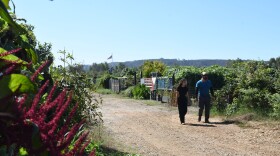BP engineers freed a diamond-tipped saw that had become stuck in a pipe in the latest attempt to contain the Gulf oil spill.
BP PLC spokesman Mark Proegler said Wednesday afternoon that the company was working out some logistical issues. The company is using the saw to slice through a pipe so it can fit a cap over the blown-out well and capture some of the spewing oil.
Officials acknowledge that the "cut and cap" procedure could end up sending more oil into the Gulf because it could remove material that has actually been restricting the flow.
"Just the way when you unkink a garden hose more water comes through, somewhat more will come through here, and the question is how much more," NPR's Richard Harris told Morning Edition.
"Engineers believe most of what's stopping the flow of the oil is actually rubble that's down in the well and some of the junk inside the blowout preventer, so they're not expecting it to be an explosive increase," he said. "But BP says maybe it'll be a 10 percent increase. The federal government just looked at it and said more than likely it'll be a 20 percent increase in the flow of oil."
Oil Nears Florida
As robot submarines worked underwater, the nation's worst oil slick drifted perilously close to the Florida Panhandle. Oil was spotted about 7 miles south of Pensacola Beach. Thunderstorms were making it difficult to track the slick, said Escambia County emergency director John Dosh, and officials hoped the weather would clear so they could get an aerial view.
It was raining and cloudy at the beach off and on. On Memorial Day weekend, hundreds of tourists enjoyed the turquoise waters, but it wasn't as busy as usual at Peg Leg Pete's Oyster Bar, a beach institution frequented by boaters who pull up behind the restaurant in a cove off Pensacola Bay.
"We are looking at a Wednesday to Friday shoreline impact, but there is a line of uncertainty that depends on the wave action and the winds," Dosh said. "Today we are in a monitoring mode."
Emergency crews began scouring the beaches for oil and shoring up miles of boom, though choppy waters from thunderstorms could send the oil over the protective lines. County officials are using the boom to block oil from reaching inland waterways, but plan to leave beaches unprotected because they are easier to clean up.
"It's inevitable that we will see it on the beaches," said Keith Wilkins, deputy chief of neighborhood and community services for Escambia County.
Making Landfall
The oil has been spreading in the Gulf since the Deepwater Horizon rig exploded six weeks ago, killing 11 workers and eventually sinking. The rig was being operated for BP, the largest oil and gas producer in the Gulf. Crude has already been reported along barrier islands in Alabama and Mississippi, and it has polluted some 125 miles of Louisiana coastline.
Some 2,000 feet above the Chandeleur Islands off the Louisiana coast, vast stretches of sheen meandered through the water, some reflecting pale rainbow colors. Farther away, swaths of oil in various sizes and thickness — from pale, barely detectable streams to rust-rimmed blue and purple patches that looked like giant bruises.
"The problem is this oil now is really like a collection of smaller spills," Allen said during a flight in a C-144.
Allen, the national incident commander for the spill, said the threat of oil hitting the coast was shifting east, and skimmer vessels would be working offshore to intercept as much crude as possible.
Earlier this week, BP officials said they were concentrating cleanup efforts in Louisiana because they did not expect oil to reach other states.
More federal fishing waters were closed, too, another setback for one of the region's most important industries. More than one-third of federal waters were off-limits for fishing, along with hundreds of square miles of state waters.
BP Stock Recovers
In remarks at Carnegie Mellon University in Pittsburgh, President Obama said that it's time to roll back billions of dollars in tax breaks for oil companies, and use the money for clean energy research and development. He said the catastrophic Gulf oil spill shows that the country must move toward clean energy, tapping natural gas and nuclear power, and eliminating tax breaks for big oil.
The Justice Department also has announced it started criminal and civil probes into the spill, although the department did not name specific targets for prosecution.
Shares in British-based BP PLC were down 3 percent early Wednesday before recovering in London trading, a day after a 13 percent fall. U.S.-listed shares of BP climbed 3.1 percent to $37.66. BP has lost $75 billion in market value since the spill started with an April 20 oil rig explosion, and analysts expect damage claims to total billions more.
Democratic Sens. Charles Schumer of New York and Ron Wyden of Oregon are pressing BP to delay plans to pay shareholder dividends worth an expected $10 billion or more until the full costs for cleaning up the oil spill in the Gulf of Mexico are calculated. The senators called it "unfathomable" that BP would pay out a dividend to shareholders before the total cost of the cleanup is known.
In a letter to BP CEO Tony Hayward, the lawmakers said taking action to "move money off of the company's books" will make it more difficult for BP to pay the U.S. government, fishermen and others affected by the environmental disaster.
BP PLC has paid an estimated $1 billion to clean up the oil leak and expects to spend billions more.
Just A Stopgap Until August
BP has tried and failed repeatedly to halt the flow of the oil, and the latest attempt, like others, has never been tried a mile beneath the ocean. Experts warned that it could be even riskier than the others because of the chances that slicing open the 20-inch riser could unleash more oil.
"It is an engineer's nightmare," said Ed Overton, a Louisiana State University professor of environmental sciences. "They're trying to fit a 21-inch cap over a 20-inch pipe a mile away. That's just horrendously hard to do. It's not like you and I standing on the ground pushing — they're using little robots to do this."
Engineers have put underwater robots and equipment in place this week after a bold attempt to plug the well by force-feeding it heavy mud and cement — called a "top kill" — was aborted over the weekend. Crews pumped thousands of gallons of the mud into the well but were unable to overcome the pressure of the oil.
BP's best chance to permanently plug the leak rests with that pair of relief wells that won't be completed until August. Meanwhile, BP is developing contingencies for its latest plan. The approach of hurricane season is one concern, according to NPR's Harris.
"The initial plan has a rigid pipe that goes from this [destroyed] blowout preventer up to the surface. And you can't operate in a big storm when you're doing that," Harris said. So BP plans to build a secondary system with a flexible pipe that could allow a ship to weather the wind and the waves while continuing to collect the oil. "Otherwise, it's spilling back into the Gulf," Harris said.
But he stressed that it's all a stopgap. A new well that should be completed two months from now will connect with the bottom of the broken well.
"It's called a relief well, but what it's really supposed to do is intersect with the bottom of the existing blown-out well, and if they can hit that well, they can pump cement down there and permanently stop the oil inside that old well from flowing up anymore," Harris said. The second new well being drilled is a backup, in case the first one doesn't work.
NPR's Debbie Elliott contributed to this report from Orange Beach, Ala. Material from The Associated Press was used.
Copyright 2022 NPR. To see more, visit https://www.npr.org. 9(MDAzMjM2NDYzMDEyMzc1Njk5NjAxNzY3OQ001))





